
When it comes to SEO for B2B companies, it’s not just another tactic to tick off the marketing list—it’s the cornerstone of building meaningful, long-lasting business relationships. Unlike B2C buyers who often make fast decisions, B2B buyers follow a detailed journey that involves research, comparisons, and multiple decision-makers. This means your strategy must do more than just get your pages to rank. It needs to establish trust, answer complex questions, and attract qualified prospects ready to engage.
In this guide, we break down a practical, modern approach to strategy designed specifically for companies that want to grow with intention. From optimizing your technical setup to crafting content that resonates and distributing it smartly, you’ll learn how to boost organic visibility, draw the right traffic, and convert visitors into committed clients. Let’s unlock the full potential of SEO—not just as a tool for clicks, but as a powerful driver of sustainable business growth.
B2B SEO isn't just about driving traffic—it’s about attracting the right kind of attention from high-value prospects with long-term potential. Unlike B2C, where decisions happen quickly, B2B buyers move slowly and carefully. Here's what sets B2B SEO apart and why your strategy needs a sharper focus:

B2B sales journeys can take weeks or even months, so your SEO content must nurture leads at every stage—from early research to final decision-making. This requires a steady stream of value-driven content that builds trust over time, helping you stay top-of-mind throughout a longer decision-making process.
You're not selling to one person but a group—technical leads, business heads, and finance teams—so your content should speak to multiple priorities across departments. Each decision-maker has different pain points and goals, so your SEO must be diversified enough to answer questions across roles and influence the group consensus.
B2B keywords often have fewer searches, but they bring serious intent; targeting them brings in quality prospects who are closer to making a real business decision. These high-intent users may be fewer in number, but they’re often more qualified and likely to convert—making your SEO efforts more cost-effective and strategic.
A strong strategy focuses on understanding your buyer’s needs at every stage from awareness to decision. By aligning your content to answer their specific questions and challenges along the journey, you attract qualified prospects and guide them smoothly toward conversion.
Before diving into keyword research or drafting content, take a step back and define exactly who you're trying to reach. A well-crafted Ideal Customer Profile (ICP) goes beyond vague industry categories. It digs into real-world details—like specific job roles, company sizes, pain points, and buying behaviors. Are your buyers marketing leads at mid-sized SaaS firms? Or procurement heads in enterprise logistics companies? Each comes with a different mindset and search intent.
By understanding these profiles, you're able to reverse-engineer their search behavior and create content that meets them exactly where they are in their journey. This step doesn’t just improve targeting—it sharpens your entire SEO strategy. Instead of chasing generic traffic, you’re speaking to high-fit prospects who are far more likely to engage, convert, and stick around.
Before you create any B2B SEO content, you need to know exactly who you’re speaking to. Defining your Ideal Customer Profile (ICP) helps you align keywords, messaging, and offers with the people most likely to buy and stay. A clear ICP turns broad traffic into focused, high-quality leads.

Getting specific here turns SEO from a guessing game into a targeted growth engine.
Not every visitor is ready to buy—and that’s exactly why aligning your SEO strategy with the buyer’s journey is critical. B2B buyers move through distinct stages: Awareness, Consideration, and Decision. Each stage has its own intent, and your content should be designed to meet those needs head-on. If you're serving product pages to someone still learning the basics, you're missing the mark. On the flip side, if you’re only offering educational blogs to someone ready to make a purchase, you risk losing the conversion.
A strategic SEO plan maps content types to these stages, ensuring that no matter where a potential customer is in their journey, they find exactly what they need. This not only increases engagement but builds trust—because you're offering value instead of a hard sell. Over time, this funnel-focused approach turns your site into a resource hub that naturally moves buyers closer to a decision.
Aligning your content with each stage of the buyer’s funnel ensures you're meeting users with the right message at the right time—turning search intent into strategic conversions.

This stage-smart SEO doesn’t just attract traffic—it guides intent and builds momentum toward conversion.
Most companies think B2B keyword research starts and ends with a few SEO tools. But if you're serious about building an effective SEO strategy for B2B, you need to go much deeper. B2B buyers search with specific problems in mind—not just product names. That’s why your keyword research must go beyond generic queries and surface the real language your audience uses when looking for solutions.
The foundation of strong B2B SEO strategies lies in understanding buyer intent. This means identifying the exact terms your prospects use when they’re actively seeking help. High-quality SEO isn’t just about ranking it’s about showing up with the right message at the right time.
In B2B, it's not just about getting clicks it’s about attracting visitors who are closer to taking action. To do that, you need keywords that reflect real needs, not just general interest.

Platforms like SEMrush, Ahrefs, and Google Search Console can help uncover low-difficulty, high-conversion phrases ideal for B2B search engine optimization.
They hear your buyers' language daily. Use their insights to identify recurring pain points and question formats.
LinkedIn groups, Reddit threads, and forums often reveal how your audience frames their challenges in their own words.
Look for keywords with commercial intent like “solutions,” “services,” “platforms,” and “best tools” to align with mid-to-bottom funnel queries.
Instead of targeting broad terms like “CRM software,” think like a buyer searching for:
These types of queries reflect higher buying intent and often face less competition—making them powerful for B2B SEO best practices.
Effective SEO for B2B isn’t about chasing volume—it’s about targeting clarity. When your keywords match real business needs, your content becomes the trusted answer your audience is searching for.
Content is the engine that powers successful optimization but simply publishing blog posts isn’t enough. To drive real results, your content must be built with purpose: aligned with buyer intent, mapped to the funnel, and crafted in formats that support both discoverability and conversion. In a competitive B2B space, the brands' winning search aren’t just creating content—they're creating the right content.
A well-rounded strategy includes multiple content types, each designed to meet buyers where they are and guide them toward a decision. From educational resources to proof-driven assets, every piece plays a role in helping search traffic evolve into pipelines.
Effective B2B SEO relies on a variety of content types that speak to buyers at every stage of their journey. From building awareness to closing deals, the right mix helps establish authority, address concerns, and drive conversions.
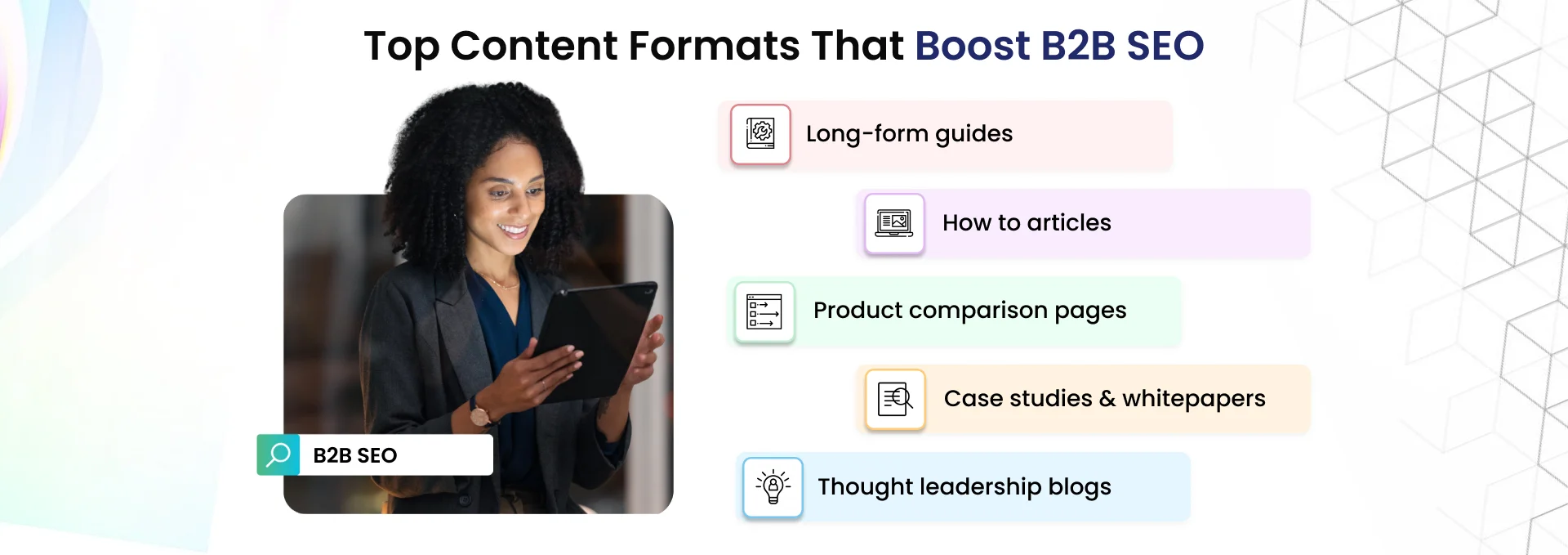
Deep, authoritative content (2,000+ words) that ranks well for awareness-stage keywords. Perfect for terms like “what is supply chain visibility” or “B2B lead generation strategies.”
Actionable, tactical posts that answer specific questions or challenges. For example: “how to streamline invoice approvals in SAP.”
Mid-funnel content using “X vs Y” keywords (e.g., “HubSpot vs Pardot for enterprise”) to attract prospects actively evaluating solutions.
High-conversion assets that validate your solution through real-world results. These shine at the decision stage of the buyer’s journey.
Trend-based or opinion-led articles that position your brand as a forward-thinking authority. These help with brand awareness and SEO differentiation.
Creating content that performs well in B2B SEO means balancing clarity, relevance, and user experience. Following proven best practices helps your content rank higher and keeps your audience engaged throughout their buying journey.

You can publish the most insightful content, but without solid on-page optimization, it’s likely to stay buried in search results. In B2B SEO, where competition is fierce and buyers are short on time, your page must instantly signal relevance to both Google and the decision-makers scanning it. That’s where on-page SEO becomes the unsung hero of your entire strategy.
Effective SEO means going beyond keywords. It’s about creating a structure that search engines can easily crawl and users can effortlessly navigate. From meta data to headers and schema, these on-page elements determine whether your content gets seen—or gets skipped.
On-page SEO is the foundation of your website’s visibility and user experience. Optimizing these key elements ensures that search engines understand your content clearly, while making it easier and more appealing for visitors to navigate and engage.
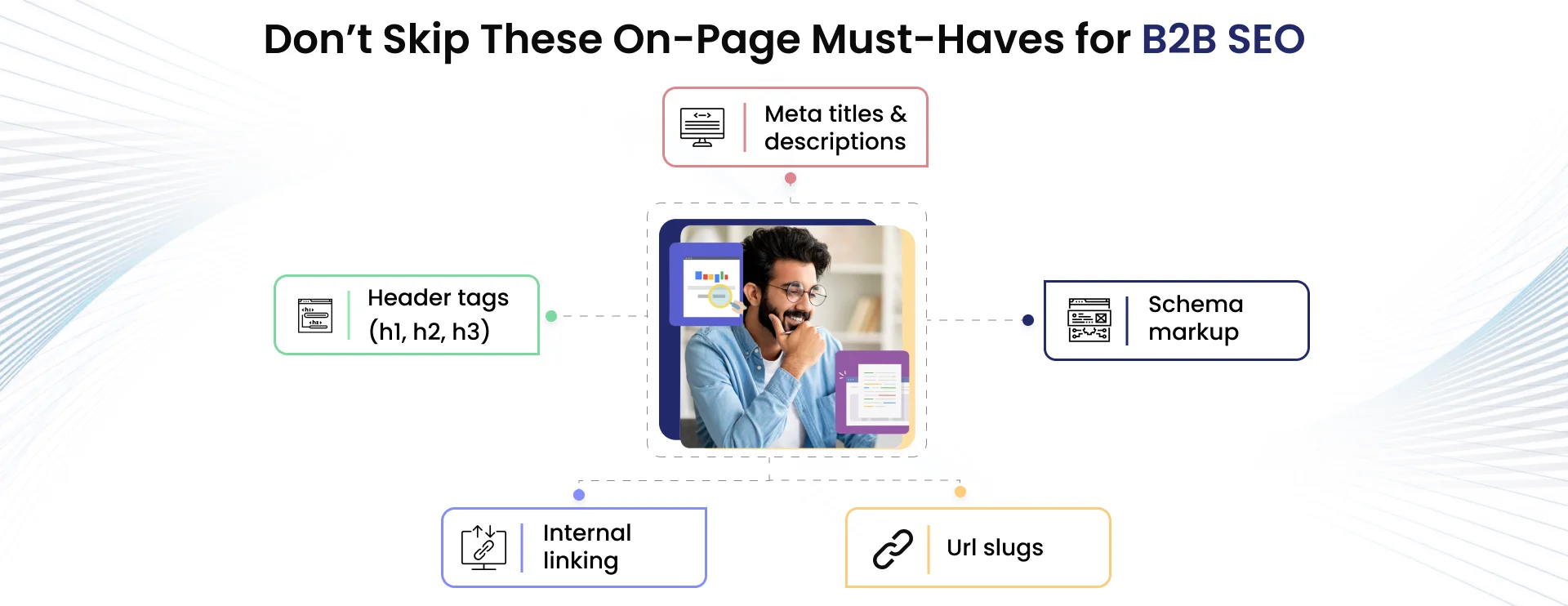
This is your page’s elevator pitch. Include primary keywords and make your title compelling enough to earn the click. Keep it under 60 characters for titles, and under 160 for descriptions.
Use H1 for the page’s main title, followed by H2s for key sections and H3s for sub-points. Incorporate keyword variations naturally—this helps both SEO and readability.
Link related blog posts, services, or key landing pages. This helps Google understand your site’s hierarchy and keeps readers exploring deeper into your funnel.
Avoid cluttered URLs. Stick to 2–5 words, include the main keyword, and remove stop words (like “and” or “the”) to improve clarity and ranking potential.
Implement structured data like:
FAQ schema for expandable answers in search
Organization schema for brand visibility
Review schema to display stars and testimonials
Rich snippets improve click-through rates, especially valuable in search engine optimization, where trust indicators matter more.
Think of your website like a high-performance vehicle. Your content might look polished on the outside, but if your technical foundation is shaky, you're not going far. In the world of B2B search engine optimization, technical SEO is what keeps your entire engine running smoothly behind the scenes. Without it, even the most compelling blog or perfectly written landing page won’t reach its audience—or rank where it matters.
For companies investing in SEO for B2B, ignoring technical SEO means leaving growth on the table. Google’s algorithms favor websites that are fast, mobile-friendly, secure, and easy to crawl. If your site doesn’t meet these standards, your content won't get the visibility it deserves—and buyers won’t stick around long enough to convert.
Technical SEO forms the backbone of your website’s performance and visibility. Keeping these essential elements in check ensures that both users and search engines can access and navigate your site smoothly, setting the stage for your content to shine.
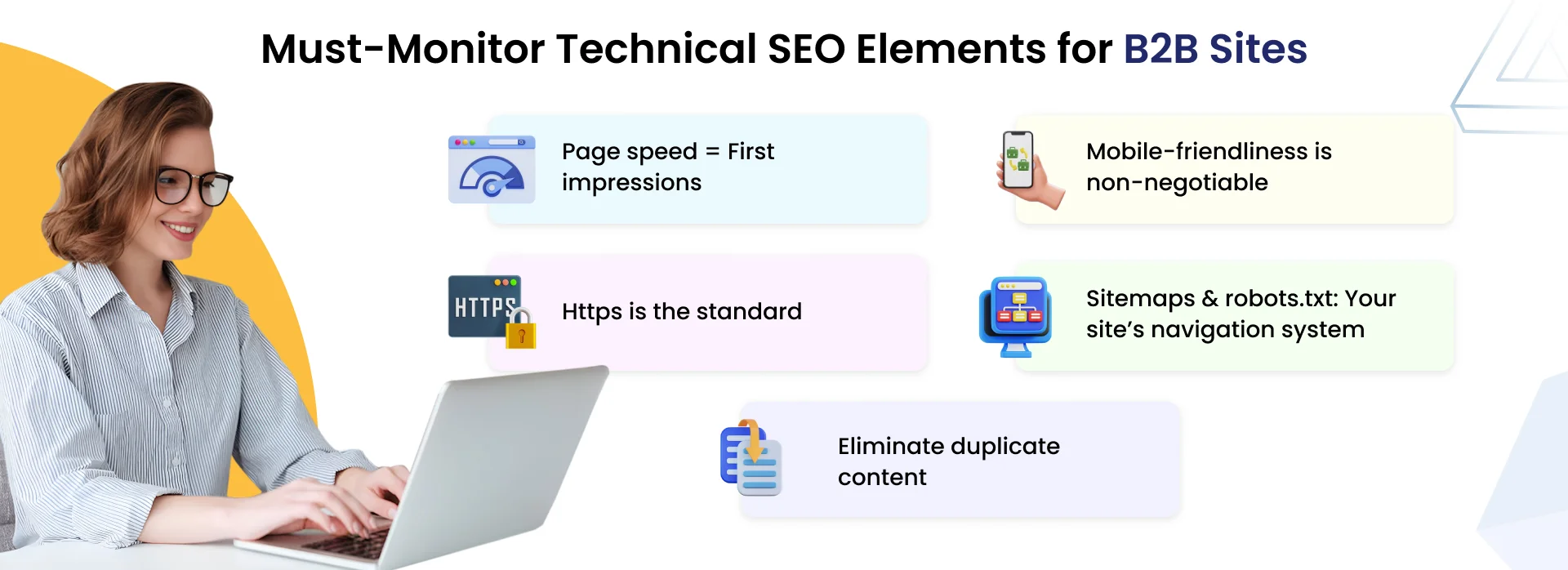
Visitors judge fast. If your site takes more than a few seconds to load, they’ll bounce. Compress images, eliminate render-blocking scripts, and use a CDN to maintain high performance.
Even in B2B, mobile traffic is growing. Your site must render perfectly on all screen sizes—no zooming, broken layouts, or frustrating tap targets.
Security is critical, especially for enterprise buyers. If your site isn’t HTTPS, you’re sending the wrong message. It’s also a confirmed ranking factor in Google’s algorithm.
A well-structured XML sitemap helps search engines discover and index pages efficiently. Meanwhile, a correctly configured robots.txt file ensures they’re not wasting time crawling pages you don’t want indexed.
Duplicate or near-duplicate pages dilute your rankings. Use canonical tags to signal the preferred version of a page and consolidate link equity.
Regular technical audits are one of the most overlooked B2B SEO best practices, yet they often uncover the hidden issues holding your rankings back. With a solid technical SEO foundation, your content can finally perform the way it was intended—attracting, engaging, and converting the right audience.
In the world of B2B search engine optimization, link building isn’t about chasing numbers—it’s about building credibility. Google sees high-quality backlinks as votes of confidence, and in B2B, trust is everything. One authoritative link from an industry leader can do more for your strategy than dozens of irrelevant mentions from low-authority sites.
Unlike B2C, where viral content and influencer mentions can generate fast traction, SEO for B2B relies on building long-term authority through strategic partnerships, original insights, and value-driven collaboration. You're not just earning links—you're earning trust in a way that both search engines and human buyers recognize.
Link building remains a crucial part of any strong B2B SEO plan—but it’s not about chasing quantity. Building genuine, high-quality connections through strategic efforts helps boost your site’s authority and drives targeted traffic that converts.

Skip the spray-and-pray outreach. Focus on reputable industry blogs or niche publications where your audience already goes for information. Offer actionable, well-researched content that reflects your brand’s expertise—not generic fluff.
Create joint case studies with satisfied clients. These stories not only demonstrate real outcomes but often earn natural backlinks when your clients feature or share them. It’s SEO plus social proof in one move.
If you have proprietary data, turn it into something people want to cite: surveys, reports, benchmarks, or trend analyses. High-authority sites love linking to fresh insights that add depth to their own content.
Relevant directories still matter—if they’re selective and aligned with your industry. Whether it’s a SaaS marketplace, association site, or vendor listing, being present in the right places supports both SEO and discoverability.
Don’t just send press releases—share stories worth telling. Announce a product breakthrough, thought-provoking research, or unique customer milestone. Media mentions from trusted publications often come with high-authority backlinks.

Strong link building isn’t a quick win, it's a trust-building process that pays off in visibility, rankings, and long-term relationships with both Google and your buyers.
Getting to page one on Google? It feels great. But in the world of SEO, rankings are only part of the equation. What really matters is what those rankings deliver—qualified leads, conversions, sales conversations, and actual pipeline momentum. A successful strategy should always be evaluated through a lens of business impact, not vanity metrics.
Your audience isn’t clicking impulsively—they’re researching, comparing, and making high-stakes decisions. That means your SEO success should be measured based on quality over quantity, intent over impressions. The real win isn’t traffic—it’s traction.
Measuring success in B2B SEO goes beyond just traffic numbers. To truly understand the impact of your efforts, you need to track the metrics that reflect real buyer intent, engagement, and revenue growth.
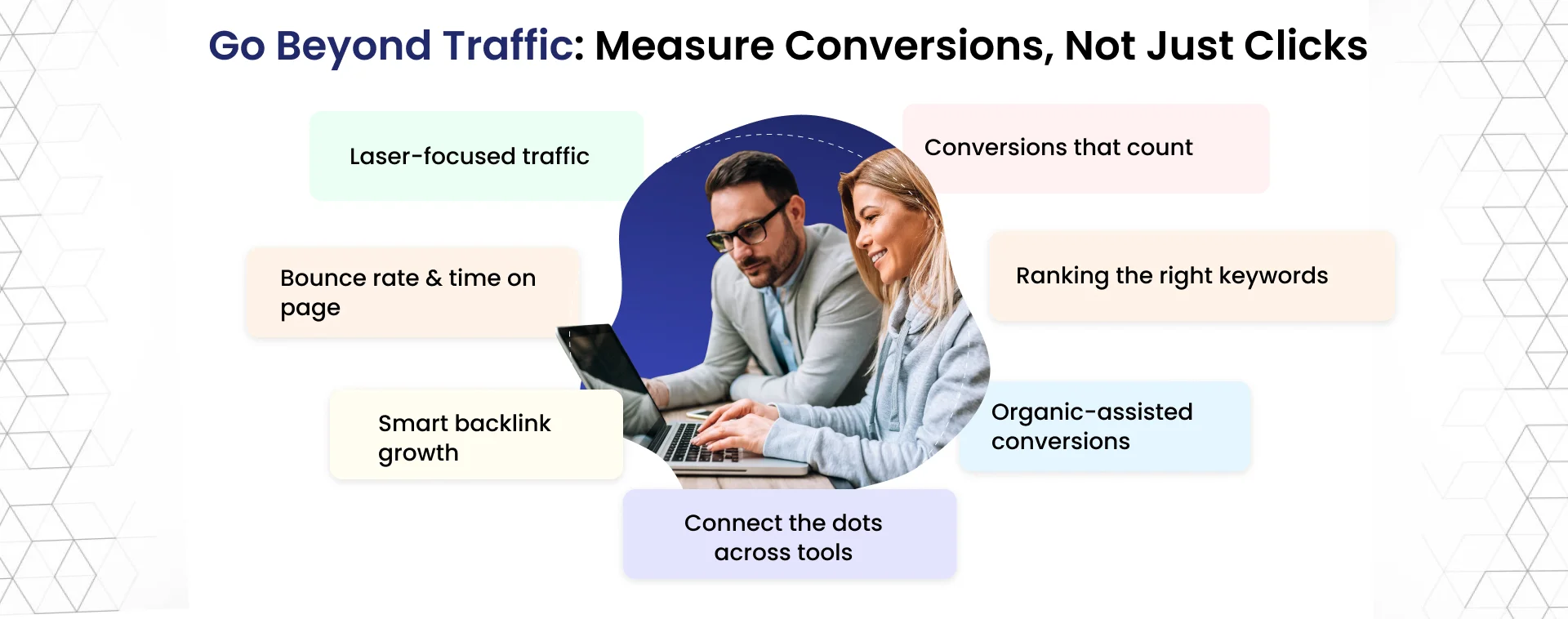
Track visits to key decision-making pages like service pages, industry-specific solutions, and product use cases. These pages signal intent from buyers with budget and authority—not just top-of-funnel interest.
Look beyond traffic and ask: are people booking demos, submitting contact forms, or downloading gated assets? These are tangible indicators that your B2B search engine optimization efforts are aligned with business goals.
If users exit quickly, something’s off—whether it’s content mismatch, poor UX, or irrelevant keywords. But if they stay, scroll, and engage, you’ve likely nailed the match between search intent and content delivery.
Avoid obsessing over broad terms with massive search volume. In B2B, it's the long-tail, intent-rich phrases like “best ERP for mid-sized distributors” that bring real leads. These are the keywords that drive qualified pipeline—not just clicks.
Track links from high-authority, industry-relevant domains. It’s one of the most overlooked B2B SEO best practices—and one of the most powerful credibility signals for both Google and your prospects.
Many B2B buyers return multiple times before taking action. Use GA4 and attribution modeling to uncover how organic search supports conversions, even if it’s not the final touchpoint.
Use GA4, Search Console, and your CRM to build a complete view—from traffic to closed deals. When you can link SEO activity to sales outcomes, you’re not just ranking—you’re generating revenue.
In B2B SEO, success isn’t about showing up—it’s about showing up for the right people, at the right time, with the right message. Track outcomes that move your business forward—not just metrics that look good on a dashboard.
Writing a great piece of content is only half the job. In B2B SEO, if you’re not promoting it, you’re burying it. Your blog deserves more than a quiet launch—it needs a distribution strategy that gets it seen, shared, and acted on.
Creating great content is just the start. To maximize its impact, you need to share it strategically where your B2B audience spends time turning insights into conversations and connections that move the needle.
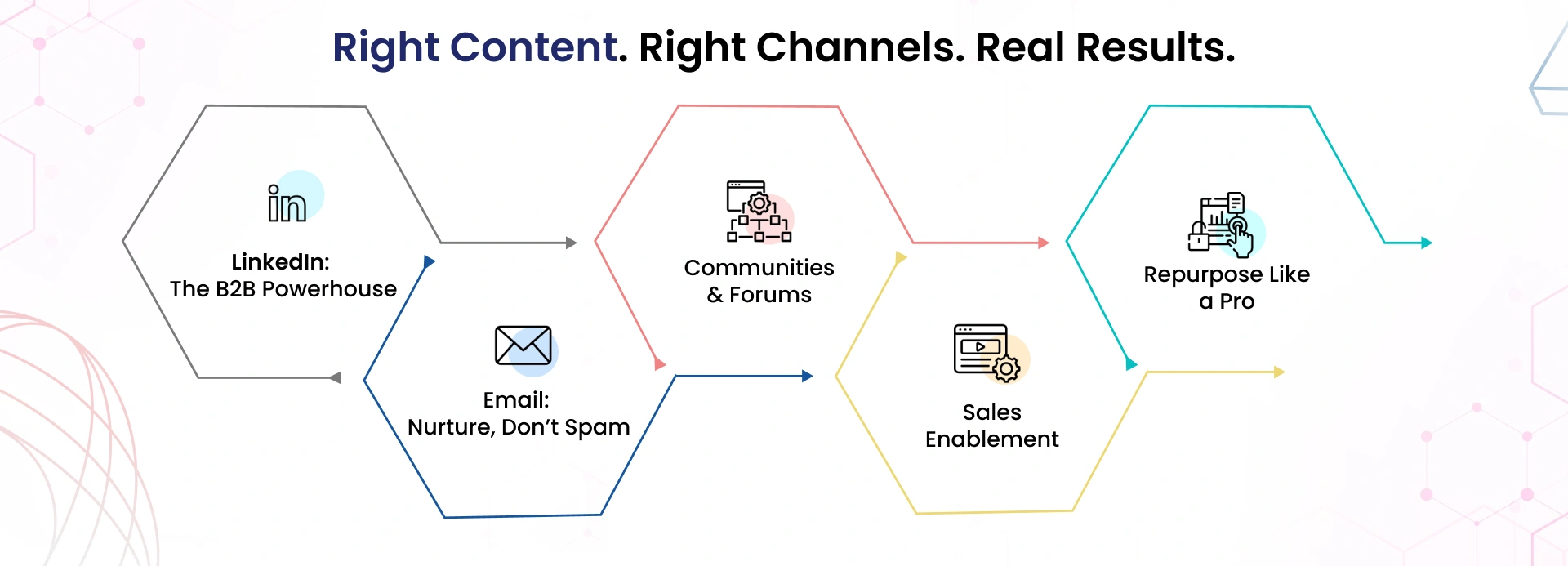
Turn your blog into bite-sized carousels, punchy thought threads, or quick video explainers. Speak directly to your industry, and your content will do more than sit—it’ll spark conversations.
Weave your best content into email campaigns, drip sequences, and newsletters. Educational content builds trust—and keeps your brand top-of-mind.
Drop value in places like Reddit, Quora, or Slack groups. Answer real questions with real insights. Don’t lead with links—lead with usefulness, and traffic will follow.
Give your sales team ready-to-share articles and guides that help them educate, not just pitch. Great content makes cold outreach feel a lot warmer.
One solid blog can turn into a checklist, infographic, short video, SlideShare, or even a podcast topic. Stretch your content across formats to reach people where they are.
The world of B2B search engine optimization isn’t static—what worked last year may not work tomorrow. As search behavior evolves and AI reshapes how content is delivered and consumed, B2B marketers must stay ahead of the curve. Future-proofing your strategy means adapting to how buyers search, how algorithms understand content, and how visibility is earned in new formats like AI-generated answers.
To stay competitive, it’s no longer enough to optimize for traditional search engines alone. From voice queries to AI-driven search results, these emerging trends are redefining how SEO for B2B works.
The world of SEO is evolving fast, especially in B2B, where innovation can create a competitive edge. Staying ahead means embracing new technologies and approaches that reshape how buyers find and interact with your brand.

Search engines like Google now rely heavily on machine learning to interpret context, not just keywords. To adapt:
With tools like ChatGPT and Google’s Search Generative Experience (SGE), users are increasingly receiving answers without clicking. Your goal? Be the answer.
As mobile and voice-assisted devices become more common in B2B research, voice search matters more than ever—especially among on-the-go executives.
To signal topical authority and improve internal linking, structure your site around key themes:
By embracing these shifts, your brand stays discoverable, credible, and competitive—even as the search landscape evolves. The best B2B SEO strategies aren’t reactive—they’re proactive, adaptable, and built to stand the test of algorithm updates and buyer behavior changes.
B2B SEO isn’t just about driving traffic—it’s about earning the trust of high-intent decision-makers and guiding them through a more thoughtful, complex buying journey. As competition intensifies and search behavior evolves, the companies that connect SEO with buyer intent, strategic content, and technical precision will always stay ahead. Great B2B SEO doesn’t stop at visibility; it fuels a consistent stream of qualified leads and drives long-term business growth.
At JanBask Digital Design, we specialize in B2B SEO strategies that go beyond keywords. From targeting niche markets and influencing multiple stakeholders to building content that converts across the entire funnel—we help businesses turn organic search into real revenue. Whether you're looking to boost lead quality, shorten your sales cycle, or build authority in your space, our team is here to make your growth goals happen.
Start Growing with Strategic B2B SEO

A
One of the best B2B SEO blogs I’ve read. It’s practical, well-researched, and delivered real value to our team.
C
This article is a must-read for B2B marketers. I liked how it addressed account-based SEO and intent-driven content. The examples helped connect the theory to actual execution.